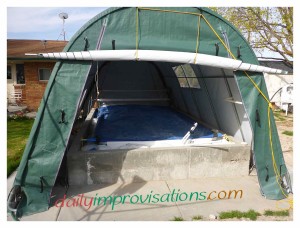I have been swimming in my Tuff Pool with the Endless Pools’ Fastlane current generator for about one and a half years now. With another spring begun, it seemed like a good time to review and update what I’ve learned at this point. Some of it is applicable to swimming anywhere, as I have verified by swimming in pools and lakes in a few other places. Some of it is best learned while swimming in a current, or specific to problem solving the differences between swimming in still water (as it basically is in a swimming pool) and swimming in moving water (which most open water will be, especially in triathlons). This will obviously lead to more ideas to experiment with and more potential goals!
1. Dealing with sea sickness or motion sickness while swimming. Since my original post about this issue, I have fine-tuned my understanding of how factors affect this.
- The speed of the current matters some. Faster moving water is harder to adjust to, because it tends to move me around more. This added movement seems to make me more susceptible to getting sick, but I am not always affected the same by the same speed. Other factors, listed below, have significant impact. It is interesting to note that when in a boat, I do better when the boat is moving faster and become the sickest when said boat stops and rocks on the waves.
- Having a snack relatively close to when I begin to swim helps to keep my tummy happy. I have done well eating crackers, sometimes with butter, cheddar cheese, and apples. Anything that is roughage, such as cabbage or lettuce turns out to be very bad. I shouldn’t be too full, though.
- How tired I am matters. This seems to be mostly due to a tired body being less relaxed and less able to swim in smooth, controlled manner.
- Swimming smoothly matters a lot. If I find a steady, but relaxed rhythm to my stroke, the water is more of friend than a conquest. This keeps me swimming straighter and is less tiring.
- If I haven’t been able to swim in the current for a while, say due to illness or vacation, it takes some time to get used to it again, but not as long as it did at first.
- Where I look while swimming is important. I can look up slightly, to focus on the bottom of the current generator, which helps me stay straight, but trying to look around the pool seems to mess with my inner ear too much so far. I am still trying to work out how to practice sighting in the current.
- Keeping the water level up keeps the current flowing more smoothly.
- Turning off the current generator, even for half a minute, during breaks mitigates any creeping nausea.
- Giving into some good burps relieves pressure building in the stomach. I never force this, and don’t know why so much air gathers down there when I swim, but I find that I feel much better after several good belches, like no others that I have at any other time in my life!
2. Working on my stroke for optimum pull and minimal muscle strain.
- Although there is improved muscle memory and overall comfort with swimming, it helps to think about the basic principles that I have learned from my Flowaquatics lessons, the book by Sheila, and reminders from Mr. Smooth blogs every time I swim. I have been learning that it doesn’t have to be a hard workout or mentally strenuous to remember these things, but just being conscious of them helps.
- In particular, keeping my elbows at a 90° angle when pulling through the water helps both alleviate and avoid arm strain. If I am having some discomfort, I can usually make it disappear simply by doing that. Practicing in a shallow pool can help develop this, as I discovered when swimming in a hotel pool on vacation. Two and a half feet of water worked fine for laps if I kept those elbows bent!
- It is hard to feel I am doing the ‘hip switch’ adequately while in the current, especially if I need to stay smooth. Still, if I just think about which part of my body is going to be activated, it seems to help. This also works with trying to use my lats (latissimus dorsi, back muscles).
3. Aerobic conditioning can be done at a comfortable level.
- Half the battle of finding the correct current speed or swim speed in a pool, was finding a speed that lets me breath every third stroke at a rate that doesn’t leave me panicked between air time. Of course, making sure I’m exhaling steadily while underwater always has a lot to do with this. And, the more I swim, the more natural it is to breath at a set rate without feeling the lack of “opportunity” to breathe. 🙂 Since this has become more natural to me, my endurance is increasing without the stress of ‘trying hard.’ Strangely enough, I sometimes catch myself thinking about taking a breath under water just because I am so at ease and have forgotten I AM underwater!
- When I have gone to swim in a pool, or more still water, I find it so comparatively easy that I feel like a water skipper. I do also have to concentrate on mostly slowing down my pace so that I don’t strain my arm muscles in the flurry of motion that seems so easy when there is little character to the water.
- Time intervals of swimming, without taking a break for anywhere from 5-25 minutes (my max recently), seem to be very effective at increasing endurance without any speed work.
4. Pool set-up and maintenance make a big difference.
- My winter cover made swimming all winter much easier. I was warmer, the cover didn’t collect snow and water, making it hard to access, and it gave me a good place to hang my towel. 🙂 The cover will probably stay on until mid May, based on past Idaho weather.
- The door on one end is operational now, meaning I can have more fresh, spring air and sunshine as it is available
- Dealing with the pool chemicals is getting easier all the time, although I have had some trouble with algae when urgent family situations or vacations have distracted me for too long. However, I have also discovered that a little algae isn’t as scary as I thought it might be and I didn’t have to stop swimming while working on the issue.
5. Things I’m still interested in.
- I wish there was a better way to tell what speed I’m setting the current to. I can go by how the flow looks some, but that changes with the water level compared to the current generator. My engineer may work on a contraption for this.
- I need to see if getting in more times per week and/or more than once a day are doable. The summer months should give better opportunity and motivation for that. 🙂
- I still need to sew swimsuit fabric “socks” to help keep me warmer for winter swimming. I know I won’t wear them the whole time, but there will be a psychological advantage for getting into the water.
- I still have a goal of increasing my uninterrupted interval length to near an hour about once a week.
The bottom line is that I am really enjoying my unique backyard swimming pool! I’m finding maintenance more manageable than I had thought it might be. I am getting comfortable in the water in ways not possible in a lap pool, and all I have to do to swim is wander out my back door. 🙂

